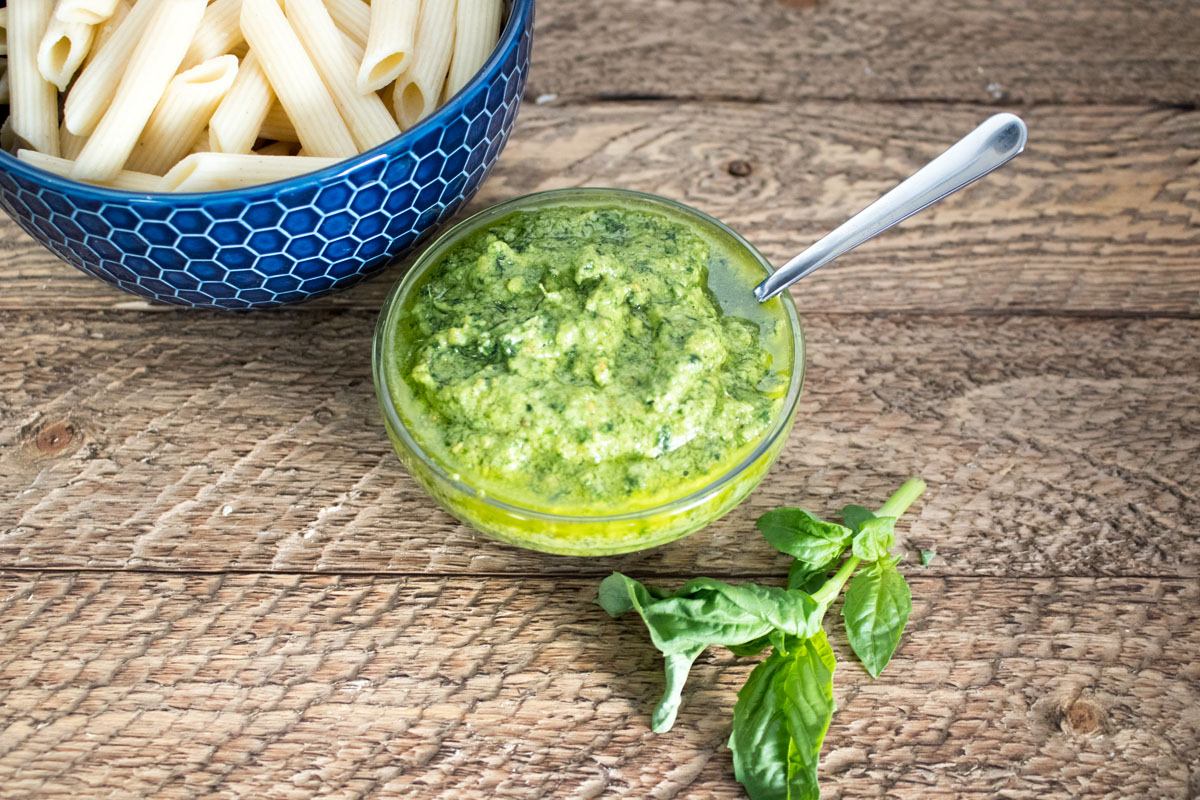They say that travel can inspire and that was certainly the case for our Genovese Style Pesto recipe. On a 2018 trip to Italy, we spent some time in the city of Genoa whose culinary credits include being the birthplace of this delicious green sauce. Not only did we try some at a small cafe (just steps from Christopher Columbus house) but we took away an understanding of how the pesto they make in Genoa is different from what we have here in the United States. Let’s take a quick look at what makes the Genoa Pesto is different from ours, and what we can do to make it as authentic as possible.
The Dish: Genovese Style Pesto

Traditional Genoa pesto is made with basil, pine nuts, garlic, cheese, and olive oil, mashed together with a mortar and pestle. Early recipes date back to at least 1 AD where a Roman poem mentions a recipe made with herbs rather than basil. In the Middle Ages, we have another evolution of the recipe in Genoa where garlic was a staple in the seafaring class of the city, but basil is not yet the main ingredient. By the 1860’s the modern version with basil is well documented in and around Genoa.
With the quick history out of the way, let’s look closer at two of the indrediants that stand out.
The Basil:
In Italy in order to call your product Genovese Pesto, it must be made with a specific variety of basil (Ocimum basilicum genovese) or simply put Genovese Sweet Basil. This basil is grown in and around the city of Genoa and has special protection in the European Union. It will take some work, but you can find it in the United States, but there is an alternative that we can use. Sweet Basil (ocimum basilicum) is the most common basil in the United States and should be available in every grocery store. While the Genovese Sweet Basil has a more robust flavor than the Sweet Basil, it is minor and will still create great pesto.
The Cheese:
The cheese used also makes a difference. In the United States Paramigan is the most common, but to make it in the traditional Genoa style we want to use a mixture of Parmigiano-Reggiano and Pecorino Sardo. You may need to ask your grocer if they carry Pecorino Sardo (look for it in the deli section) but this sheep’s cheese with a mild nutty flavor really makes an impact on the pesto.
Our other ingredients, olive oil, garlic, and pine nuts are straight forward. If you can, look for pine nuts from the United States and not from China to avoid “Pine Mouth.”
Kitchen Equipment Needed:
- Mortar and Pestle (only if going old school)
- Food Processor
- Blender
- Measuring Cups
Tradition dictates that you use a mortar and pestle to make your pesto, but most of us to not have one nor have the time to use this method. Lucky for us we can use a food processor or a blender to achieve the same results.
Making Genovese Style Pesto:

Step 1 
Step 2 
Step 3
This is so easy to make. We are going to take the basil, pine nuts, and garlic and place them in the blender. Blend for about a minute until everything is roughly chopped up. Then add the grated cheese and blend again for another minute. Finally, add the olive oil and blend again for about 2 minutes until your pesto reaches the right consistency. If serving immediately with pasta, add ¼ cup of the pasta water to the pesto and mix until incorporated. This will ensure the sauce clings to your pasta and not just pool on your plate. The pesto is best served fresh, but it can stay in the refrigerator for about a week.
Genovese Style Pesto
Course: SauceCuisine: ItalianDifficulty: Easy8
servings5
minutes5
minutesIngredients
2 cups, Fresh Basil
2 tbsp, Pine Nuts
1/2 cup, Parmigiano Reggiano
1/2 cup, Pecorino Romano
1/2 cup, Olive Oil
1/2 tsp Ground Black Pepper
1/2 tsp Kosher Salt
Directions
- Place basil, pine nuts, and garlic in a food procession and blend about 1 minute for a rough chop.
- Add both cheeses and blend again for another minute.
- Add olive oil and bend a final time for 2 minutes
Notes
- If serving with pasta right away, add 1/4 of the pasta water to the sauce along with the olive oil and serve.


